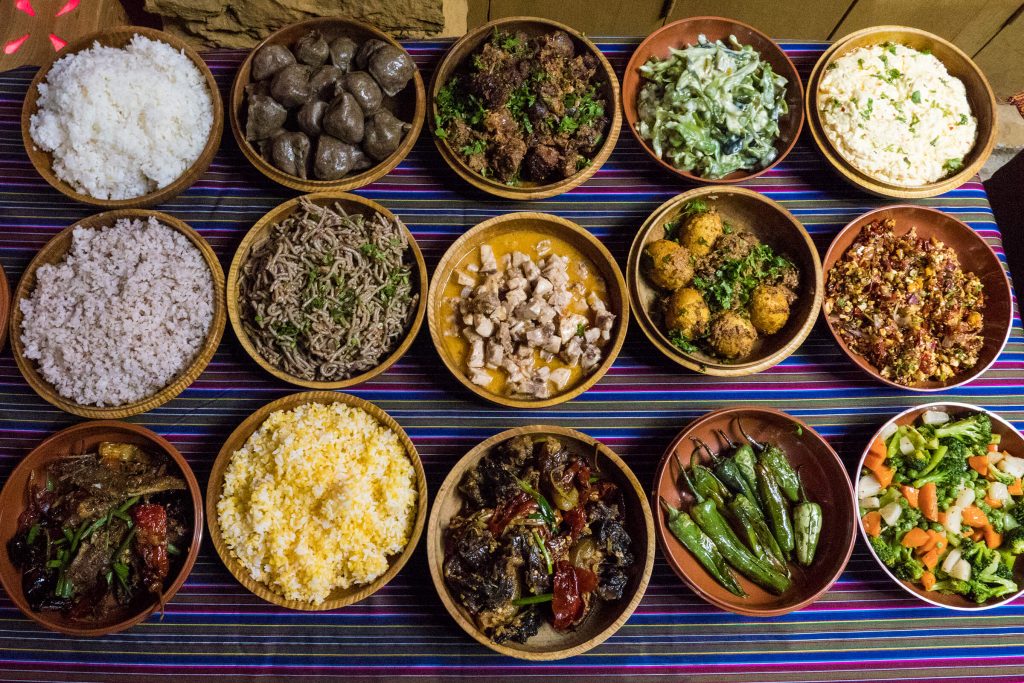The diverse (and delicious) food of Bhutan

” Unlike other countries that follow a variety of cooking methods, in Bhutan, all savory dishes are cooked either by boiling, steaming, or stewing. It has little to do with baking, frying, grilling, roasting, or barbecuing. Most often, dishes are a beautiful amalgamation of various ingredients tossed together in a pot and boiled. “
A Taste of Bhutan
The food of Bhutan takes your palate to a world of spices. Its perfect blend is a sensory treat that everyone must experience at least once in their lifetime. The diversity of taste and texture is wide. The culinary delights are influenced by India, China, and Tibet, but the local dishes remain unique. The most distinctive characteristic of Bhutanese food is its spiciness, with chillies being an essential part of nearly every food item. Additionally, delicious local cheese called Datshi makes its presence in almost every dish. Nearly all vegetarian delights are cooked with it, and hence their names always end with it.
Along with chillies and cheese, rice forms the base of a meal. Locals revere red rice more than anything else. With a nutty, earthy flavor and delicate texture, the heirloom grain is considered premium and precious. Farmers in the western-central regions have been cultivating it for centuries.
One can find chillies drying practically everywhere – on rooftops, hanging out of windows, and lying out on the ground. The kinds in which they are consumed are mind-blowing – red, green, fleshy, slender, dried, powdered, and pickled. A red chilli paste is also available, made from a combination of onion, ginger, red chilli flakes, and edible oil. Interestingly, from time to time, every house burns some chillies to keep the bad spirits or the demons away. Similarly, when brewing local liquor, 2-3 chillies are added to it – not as a topping for flavor but as a sign of good luck, so that it isn’t affected by any negative energy it comes in contact with.
Must-try Bhutanese dishes
Ema Datshi
‘Ema’ meaning chillies and ‘Datshi’ meaning cheese, Ema Datshi is the national dish of Bhutan. It is a stew made using yak cheese, garlic, oil, split chillies, onion, and tomatoes, normally eaten with red rice. Some people prefer it cheesy and without soup, while others prefer it soupier. It is available throughout Bhutan, from homes to restaurants and any places in between.
Paa
Varied types of Paa (gravy) can be found across Bhutan. Two of the most popular are Shakam Paa (made of beef) and Phaksha Paa (made of pork). The stew is made with slices of beef/pork stir-fried with whole red dry chillies and simmered slowly until tender. Radishes and spinach are added to make it more flavorful. When finished, the stew is topped with dried beef/pork, fresh green chilli strips, and served with rice.
Goep
Being a local delicacy, most travelers miss out on this dish. Goep is made from slices of tripe stir-fried with dried chillies, green onions, and small vegetables. Because of the chewiness of the tripe, it’s not popular but can be found in small eateries by the roadside.
Jasha Maroo
This is a spicy Bhutanese chicken stew made from a mix of chillies, onions, tomato coriander leaves, and freshly diced chicken.
Suja (Butter Tea)
Suja, Bhutanese tea, is made from fermented yak butter and yak milk. It is drunk as a comforter in the extreme cold and is a go-to drink for the locals. Suja isn’t just a treat to the taste buds, it has health benefits too. The salt in suja moisturizes the skin by retaining moisture. The drink also helps with digestion and its calories increase energy levels, which is why it is well-loved among the Bhutanese, especially those in the mountainous areas who work long, hard hours on difficult terrains. It is also rich in antioxidants and helps in reducing altitude sickness.
The land of Bhutan has many delicacies that will leave you drooling and wanting more. It is advisable to contact a local and ask them to take you to places that are hidden and unexplored. Visiting their homes, dining with their families, and listening to their stories is an experience unmatched by what a restaurant can provide.
Cultural Etiquette
As a tourist, it’s important to respect their culture, tradition, and habits. Here are some things one must know:
– Before eating or drinking, people throw a little food, tea, and wine into the air to pray for God’s blessing. Sometimes, it’s also common to see morsels of food kept on the floor.
– When dining in a group, both the host and the guest will wait for everyone to be served.
– The hosts usually serve themselves only after the guests have started their meal.
Nothing brings people together like food does. Conversations that revolve around dining tables become memorable and form new bonds. It’s right when they say, “the way to a person’s heart is through their stomach,” and surely, the Bhutanese have mastered that. So go ahead and visit the ‘Land of Happiness’ to create endless memories of food. But make sure to tag some foodie friends along!
